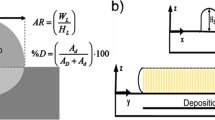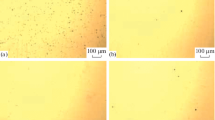Abstract
Tungsten deposition from a gaseous mixture of its hexafluoride with hydrogen on the surface of a porous billet of thoriated tungsten makes it possible to fasten the particles of peripheral layers and its core between each other, as well as to form a more plastic shell on the surface capable of relaxing stresses appearing during rotary forging, thus preventing the destruction of semifinished products. This procedure makes it possible to perform the rotary forging of a pilot batch of insufficiently sintered billets of thoriated tungsten, which would be destroyed if treated uncoated. The improvement of manufacturing properties can be used when fabricating similar tungsten-based compositions (of W(La2O3) and W(Y2O3)), as well as for other types of deformation. These results can be applicable for (i) lowering the sintering–welding temperature of bars (and rods) of dispersion-strengthened tungsten-based compositions, thereby reducing power consumption and increasing the overhaul period of equipment; (ii) increasing the sizes of semifinished products using the existing equipment thereby increasing the production process productivity and expanding the range of output products; (iii) producing less environmentally hazardous thoriated tungsten products, multiply reducing the radiation exposure of operators; and (iv) using composite cathodes in arc xenon lamps, thereby increasing their service life by a factor of 2–3.
Similar content being viewed by others
References
Svoistva i primenenie metallov i splavov dlya elektrovakuumnykh priborov: spravochnik (Properties and Application of Metals and Alloys for Electrovacuum Devices: Handbook), Nilender, R.A., Ed., Moscow: Energiya, 1973, pp. 5–38.
Amosov, V.M., Karelin, B.A., and Kubyshkin, V.V., Elektrodnye materialy na osnove tugoplavkikh metallov (Electrode Materials Based on Refractory Metals), Moscow: Metallurgiya, 1976.
Zelikman, A.N. and Nikitina, L.S., Vol’fram (Tungsten), Moscow: Metallurgiya, 1978.
Zelikman, A.N., Metallurgiya tugoplavkikh redkikh metallov (Metallurgy of Refractory Rare Metals), Moscow: Metallurgiya, 1986.
Kolikov, A.P., Krupin, A.V., Polukhin, P.I., Potapov, I.N., Bondarev, M.A., and Izotov, V.M., Tekhnologiya i oborudovanye dlya obrabotki tugoplavkikh poroshkovykh i kompozitsionnykh materialov (Technology and Equipment for Processing Refractory Powder and Composite Materials, Moscow: Metallurgiya, 1989.
Agte, K. and Vatsek, N., Vol’fram i molibden (Tungsten and Molybdenum), Moscow: Energiya, 1964.
Korolev, Ju.M. and Stolyarov, V.I., Vosstanovlenie ftoridov tugoplavkikh metallov vodorodom (Reduction of Refractory Metal Fluorides with Hydrogen), Moscow: Metallurgiya, 1981. https://doi.org/www.fluoridetech.ucoz.ru
Korolev, Ju.M., Deposition of tungsten by reduction of its hexafluoride with hydrogen under the stoichiometric component ratio: an environmentally pure production process, Russ. J. Non-Ferrous Met., 2015, vol. 56, no. 2, pp. 149–154.
Teaford, E.Q., US Patent 3359098, 1967.
Korolev, Ju.M., Gas-phase deposition—a new production process for the fabrication of wares and coatings of refractory metals. Part 2. Technology and equipment, Tsvet. Met., 1992, no. 5, pp. 41–43.
Gould, E.M., Production of porous tungsten ionizers by the deposition of coatings from gaseous tungsten compounds, Raketn. Tekh. Kosmonavt., 1963, no. 3, pp. 191–192.
Shroff, A.M., Hiveri, A., and Labbe, J., Nouvelle thechnique de realization d’emetteurs d’lon de cesium pour propulseurs electrostatiques, Rech. Aerosp., 1976, no. 3, pp. 149–155.
Jeffries, Z., Sintering of tungsten, Chem. Metal Eng., 1916, vol. 16, pp. 503–508.
Wilson, R.W., Chemical vapor deposition welding— below the recrystallization temperatures, Weld. J., 1968, vol. 47, no. 8, pp. 345–354.
Locke, S.R., Joining of tungsten and 321 stainless steel alloys by chemical vapor deposition in vacuum (10–4 torr), Vacuum, 1969, vol. 19, no. 4, pp. 179–182.
Author information
Authors and Affiliations
Corresponding author
Additional information
Original Russian Text © Yu.M. Korolev, 2017, published in Izvestiya Vysshikh Uchebnykh Zavedenii, Poroshkovaya Metallurgiya i Funktsional’nye Pokrytiya, 2017, No. 1, pp. 52–57.
About this article
Cite this article
Korolev, Y.M. Experience in Improving the Manufacturing Properties of Semifinished Products and Quality of Thoriated Tungsten Products by the Deposition of Tungsten Coatings with WF6 Hydrogen Reduction. Russ. J. Non-ferrous Metals 59, 331–335 (2018). https://doi.org/10.3103/S1067821218030070
Received:
Accepted:
Published:
Issue Date:
DOI: https://doi.org/10.3103/S1067821218030070




